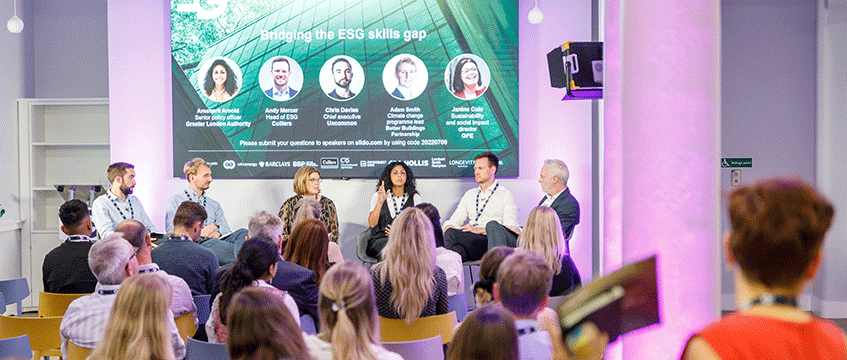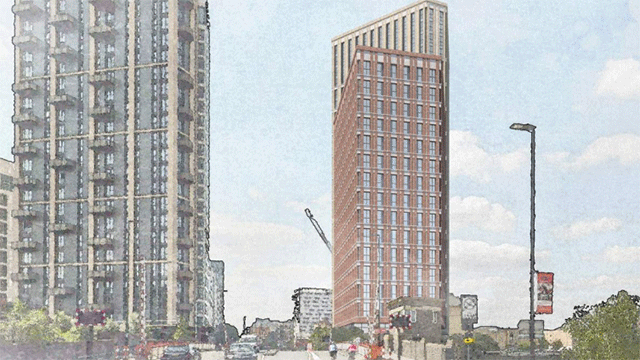What kind of talent and training does real estate’s workforce need as the ESG agenda evolves – and where are the biggest gaps? Guests at EG’s ESG Breakfast Briefing were clear: the skillset necessary to help the built environment tackle the toughest challenges in the ESG agenda can no longer be the remit of just one individual or even a team. Instead, the tools and talent must become a part of every area of business.
“Historically, the traditional ESG group would be those that are advocating and championing doing things differently,” said Andy Mercer, head of ESG at Colliers. “The interesting thing now is that because clients are increasingly interested in this – and clients that are typically investors – that is changing the dynamic slightly. What was traditionally a push of information is now being pulled. There is more interest in learning about ESG because clients are asking for it. That change in dynamic has changed the way we operate and opened the doors for our colleagues to be able to have an interest in these areas.”
The shift goes for operational real estate companies as well as investors and their advisers. At Uncommon, a provider of flexible office space, chief executive Chris Davies said: “We have had to get everyone in the company on the journey. At last count, about 80% of team members had some sort of role within our ESG strategy. That is the way you really do permeate it all the way through the business. Our members are saying, ‘Can you please provide me with X, Y and Z information’. They are all going down different routes and we are having to, as the operator of the space, make sure we have got all of the information to provide to them.”
Adam Smith, climate change programme lead at the Better Buildings Partnership, pointed to a “major ESG skills gap” in the industry. “The investment, the technology, the processes that we need to deliver a net zero transition, all need people to deliver them,” he said. “And we are hearing anecdotally from our members about the difficulties they are having in recruiting, in implementing training programs across their businesses.”
He continued: “We see the gap manifesting in the technical community and the fact that there’s an undersupply of heat pump installers and solar panel installers. In looking at our membership specifically, it is driven by the fact that regulation seems to move much more quickly than recruitment or reskilling can. So there is an issue with trying to keep up with a fast-moving ESG agenda.”
Last year, the BBP launched a training course spanning two half-days for asset managers and fund managers, looking at how to integrate ESG into investment decision-making. So far more than 600 professionals have taken part, and the course has now been opened to advisers as well.
Janine Cole, who chairs the BBP and is also sustainability and social impact director at London-focused developer GPE, encouraged a greater focus on company-wide learning.
“It is about making people understand how it relates to their day job – what’s in it for them,” she said. “We gave our development team research projects to go out and understand more about the issues around timber, issues around supply chains, around responsible steel and concrete, sustainable facades, working out the embodied carbon of facades. They feel part of the journey, they feel like they have got something real to add to the agenda.”
EG’s panel also offered some thoughts on how to attract the next generation into the built environment. Greater London Authority senior policy officer Amanprit Arnold leads an infrastructure outreach programme for the mayor, targeting primary school-aged children with the aim of building a diverse talent pipeline at an early age.
“It’s very easy to talk to an audience like you,” Arnold told EG’s audience. “But try talking to an audience of nine and 10 year olds. It is completely different and it can be quite difficult to explain your job and make it sound really exciting and interesting.”
It’s worth the push, though. As GPE’s Cole said: “We desperately need those young people coming in – they are so talented and the real estate industry really does need them.”
‘We need to act’
We are asleep at the wheel when it come to the climate crisis. A stark warning from Tom Willcock, director of innovation at Hollis, who gave the keynote speech at EG’s ESG Breakfast Briefing. But we have reached a point at which “the cost of inaction is higher than the cost of action”, he said.
“Global warming is happening. Fact. And it’s incontrovertible that man-made CO2 is causing it,” Willcock said. “The effects are now coming in waves of extremes: more frequent and more violent storms; scorched land, susceptible to more wildfires; the paradoxical-sounding combination of increased drought and greater risk of flooding.
“The world’s policymakers are aiming to limit the planet’s warming to 1.5 degrees centigrade by 2100. They hope this will limit the impacts of heat, wind and fire. But if, as is very probable, it exceeds 1.5 degrees, the tropics, currently home to 43% of the world’s population, could see air temperatures increase beyond limits the human body can withstand.”
Willcock highlighted the oft-quoted fact that the built environment accounts for 40% of emissions. “Every one of us working in and around property, we need to be aware just how big a contributor to the problem our industry remains,” he said. “It’s a gigantic problem.”
The time for debate has passed, Willcock warned. “Rather than waiting and having philosophical arguments about definitions and measurements, we need to act. Rather than building proptech solutions to complete deals a few minutes faster, or a shiny tenant engagement app to enable a tenant to book yoga a week on Thursday in the boardroom, we need to act. Sadly, they will not solve climate change.
“We have the capability to make a real difference by asking how we can effectively insulate old buildings cheaply, decarbonise heating and cooling of buildings, inexpensively get data out of buildings, optimise the kit we have already got. The challenges we face are vast and we need to have that perspective at all times. When there is any choice, we come down on the side of the environment.”
To send feedback, e-mail tim.burke@eg.co.uk or tweet @_tim_burke or @EGPropertyNews












